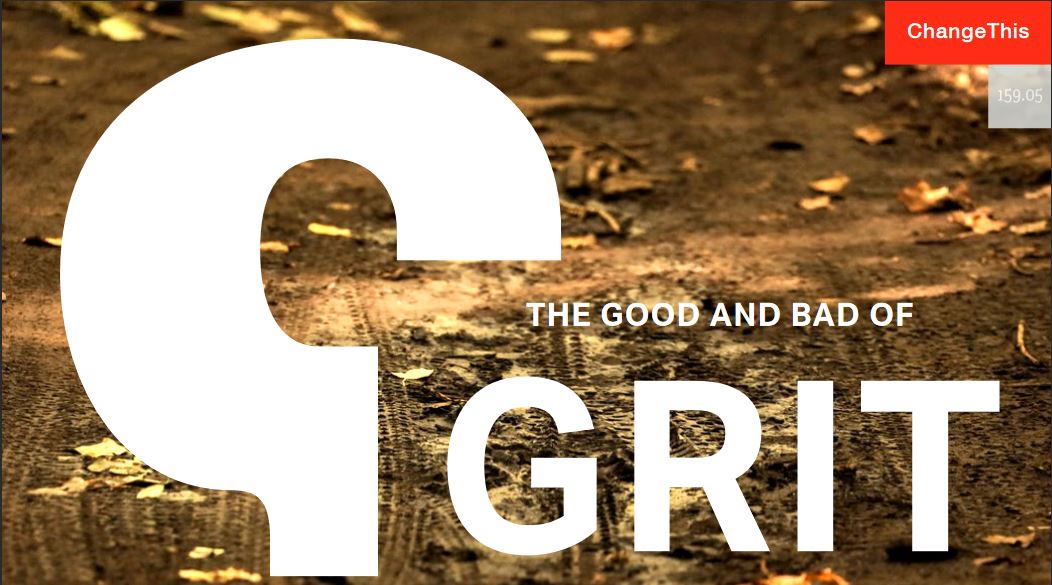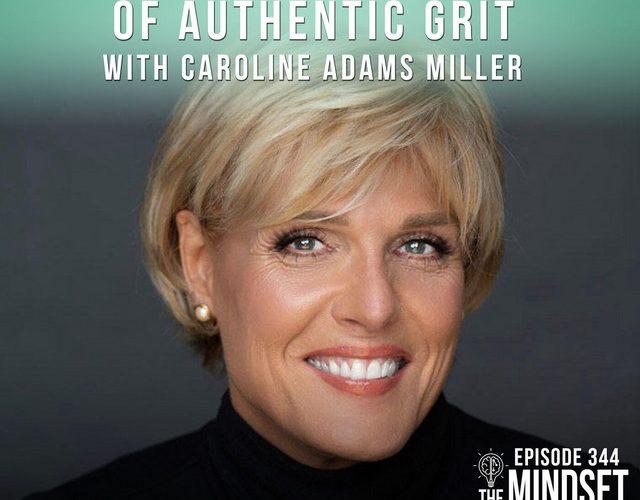December 20, 2017
The following article by Caroline Adams Miller appeared in Issue 159-05 of ChangeThis.com on December 20, 2017
“The moment people understand how passion, hard work, and dedication to a goal fit into a traditional description of grit, they usually think of someone they know who fits the definition in a good way, like Gandhi or someone in their extended family who showed them early that work pays off. But it isn’t long before they get a puzzled look and ask about Hitler. […] In order to make it easier to understand the differences between good grit and bad grit, I’ve divided up the types of positive Authentic Grit that I see in the world, along with examples to help flesh out their significance and meaning.”
At this point, you’ve probably heard of “grit.”
Angela Duckworth, probably the person most associated with it, defines grit as the perseverance and passion for long-term goals.
But not all types of grit are good.
One of the first questions I get asked when I speak to audiences about grit is:
“If someone like Adolf Hitler fits the definition of grit, how could it be a good thing?”
The moment people understand how passion, hard work, and dedication to a goal fit into a traditional description of grit, they usually think of someone they know who fits the definition in a good way, like Gandhi or someone in their extended family who showed them that hard work pays off. But it isn’t long before they get a puzzled look and ask about Hitler.
Undoubtedly, this has crossed your mind, too. You might know someone who has modeled change and passion as they’ve made a positive difference in other people’s lives, but you can probably also think of someone who became obsessed with achieving a certain kind of success, and whose drive or actions did more harm than good, and possibly didn’t even bring them joy in the process. You might even know people who have exhibited both good and bad sides of grit at different times, which might lead to confusion about how to know when you are using it well and when you need to be careful not to head in the wrong direction.
In order to make it easier to understand the differences between good grit and bad grit, I’ve divided up the types of positive grit that I see in the world, along with examples to help flesh out their significance and meaning. I will explain why each type is important and how we can benefit from identifying, studying, and emulating its finest features. Then, I tackle the grit approaches that aren’t quite as positive, along with warnings about how to avoid taking the strength of follow-through and turning it into a weapon you can use against yourself or others.
But first we’ll talk about something I call “Authentic Grit.”
Authentic Grit
Authentic Grit is the passionate pursuit of hard goals that awes and inspires others to become better people, flourish emotionally, take positive risks and live their best lives.
Authentically Gritty people have:
• Positive relationships with others
• High hope
• Humility
• Self-confidence
• A giving (not taking) mindset
• Appropriate focus
• Stubbornness
• Learned from failure
• Authenticity
• A growth-mindset
All of the types of good grit described below have all these elements of Authentic Grit.
Good Grit
There are four types of what I define as “good grit”—Mt. Rushmore Grit, Mt. Olympus Grit, Celebrity Grit, and “Ordinary” Grit.
Mt. Rushmore Grit
When I evaluated a number of great figures from history and pondered how to best describe their brand of grit, I discovered that they share some important characteristics that set them apart in noteworthy ways. These men and women are the ones who were lit up by a cause they felt passionate about and that reflected universally admired values like fairness, justice, and love. In their journey to accomplish something significant and historic, they overcame numerous obstacles—some life-threatening—but never backed down for long because of fear, despair, or loss. Their behavior was also unique for its unusual display of dignity and selfregulation. They controlled their reactions to hate, envy, or aggression directed at them from others, and in so doing, became leaders who changed the course of history and attracted followers who admired and embraced their cause, and helped change the world for the better.
I call these men and women possessors of “Mt. Rushmore Grit” because like the granite landmark in the Black Hills of South Dakota that features the faces of four of the greatest American presidents—George Washington, Abraham Lincoln, Theodore Roosevelt, and Thomas Jefferson—their deeds changed the course of history and have become enshrined in the hearts and minds of generations of grateful men and women.
They include people like Jesus of Nazareth, Mahatma Gandhi, Martin Luther King Jr., Harriet Tubman, Susan B. Anthony, and Bill Wilson, the cofounder of Alcoholics Anonymous. All of them opposed actions that represented the worst of man’s behavior—hatred, colonialism, racism, sexism, and alcoholism, to name just a few—and put their own reputation, health, and safety at risk to do so. Their ability to hold fast to their ideals and goals in spite of hardship, condemnation, and abuse is why we live in a freer, safer, and better world today.
Mt. Olympus Grit
Another type of Authentic Grit includes athletic figures who have risen to extraordinary heights, and in so doing, raised the standards for others to play bigger, outside their physical comfort zone, and to push their bodies and minds to a level that is truly awesome. While some of them are well known, many are not—but all have overcome various setbacks and challenges on the way to either making history in their sport or exhibiting a courage and class that made simply showing up to compete a gritty triumph.
Time and time again, people with Authentic Grit demonstrate that winning a trophy or medal isn’t what motivates them. What lights them up and gives them a purpose worth waking up for is seeing how far they can go as they attempt to redefine their own limits, or those of their sport, in the case of this type of grit. In so doing, they often provoke others to ponder how they, too, can be more resilient, brave, and gutsy, inspiring them to go out and test their mental and physical mettle in new ways that often change their lives for the better.
Celebrity Grit
Another common denominator of Authentic Grit is that the people who possess it never diminish the people they touch; they almost universally cause them instead to become happier or better in some way.
J.K. Rowling, Oprah Winfrey, Dick Van Dyke, and Spanx founder Sara Blakely all qualify for my Celebrity Grit designation because they are in the public eye making a difference in the lives of others, and not because they set out to do so, but because their personal stories exemplify Authentic Grit.
Ordinary Grit
Finally, we take a look at the largest group of people with Authentic Grit: the unsung heroes who wake up every day and strive to succeed at goals that require persistence and dedication, but that also lack obvious external rewards or attention and acclaim from others. These men and women selflessly take care of disabled children while holding down full-time jobs, tirelessly advocate for the less fortunate as public defenders and social workers despite low pay and depressing outcomes, or learn how to read in their sixties so that they can earn a long-desired high school degree. Although I call it Ordinary Grit, it is anything but ordinary when you look at what these people do and how they impact their families, communities, and the organizations they are part of.
Stories of Ordinary Grit go viral because we long to see paragons of goodness in a world where the motto for most news is “If it bleeds, it leads,” and the view we’re given is that of a narcissistic and angry world.
When we have an opportunity to witness heroic behavior paired with hard work, humility, and kindness, we are awed and want to share it with others. Research has found that this type of awe has the impact of releasing bonding chemicals in our bodies that enhance our pro-social behavior. So when we hear these stories, it’s medicine for the soul— and we can’t get enough of it.
The Bad…
In order to explain why it is important to cultivate the habits and mindset of Authentic Grit, it’s equally important to look at people who have seeds of the right kind of grit but who fall short of turning their actions into outcomes that make the world better or that inspire others to strive for worthy goals. These people aren’t necessarily “bad” people. However, they do provide cautionary tales about how seeking the trappings of fame, money, adulation, and success using some of the strengths that comprise grit, but without evincing key traits like honesty, kindness, and humility, can lead to a flawed outcome.
Faux Grit
“Faux Grit” is a quality seen among those who pretend to themselves or others that they have achieved difficult things, but who have taken shortcuts or faked those accomplishments to obtain admiration. Although many people readily admit to puffing themselves up at times to impress a romantic interest or a potential employer, Faux Grit takes this quality to a whole different level because of what the people allege to have accomplished. Specifically, these people choose outcomes that put them into a select, sometimes elite, group, despite knowing that they have not done, and probably cannot do, the hard work that’s commensurate with those goals.
Paul Bucha, president of the Congressional Medal of Honor Society, believes that part of the reason people claim high honors they haven’t earned is because our society prizes “winners,” and some believe that their normal lives and actions just aren’t sufficient to feel good about themselves. Faux Grit, he speculates, is a natural outgrowth of feeling the pressure to achieve important goals in order to feel validated. And if you believe you don’t have what it takes to be a winner and that you are not worthy enough without that title, it may seem better to misappropriate honors you haven’t earned than to figure out what else you could offer the world to give your life purpose.
Faux Grit is distinct from Authentic Grit in many ways, most notably because people with Authentic Grit have humility and are the last to brag about themselves. The person with Faux Grit wants you to know how much they’ve done, how hard they’ve worked, and how tough they are, and they revel in the trappings of their alleged success, whether it’s giving interviews about their accomplishments, tweeting pictures of framed yellow jerseys from the Tour de France (which Lance Armstrong did), or waving in a Fourth of July parade while wearing fake medals bought at a flea market. Instead of naturally attracting others because of an authentic aura, people with Faux Grit eventually repel others by over-promoting themselves, which then causes them to lose all sympathy with others when their misdeeds are discovered.
Stubborn Grit
I define “Stubborn Grit” as the obstinate pursuit of a long-term goal that presents more negatives than positives because circumstances have changed, and it no longer makes sense.
When climbers are drunk on their vision of summiting a mountain, having invested their time, money, and ego in reaching the peak of a vaunted site like Mount Everest, they are vulnerable to something that mountaineers call “summit fever.” Summit fever is the irrational state of pushing to the top of a mountain in spite of gathering storm clouds or ominous weather conditions that foretell an imminent whiteout or blizzard. Summit fever erases good judgment, putting your own and possibly others’ lives at risk because you are desperate to claim the prize and earn bragging rights to say you got to the top. Stubborn Grit works the same way.
A telltale sign of Stubborn Grit is hubris. Unlike the narcissism and entitlement seen in Faux Grit, Stubborn Grit’s hubris is embodied by the person who believes that they have the superhuman ability to pull rabbits out of hats—be those hats physical, emotional, or financial— and does the hard work necessary to succeed, but doesn’t heed the signs that it no longer makes sense to stay the course. Unlike Authentic Grit, Stubborn Grit doesn’t inspire others; instead, it makes one wonder why those who have it can’t see reality.
Selfie Grit
Selfie Grit is a variant of Faux Grit and Stubborn Grit in several important ways. The person with Selfie Grit brags about their achievements but did actually accomplish them, unlike the person with Faux Grit. Nor have they failed and overshot the mark with their goals, as do many who exhibit Stubborn Grit. Selfie Grit is unique; I define it as “the relentless glorification of one’s pursuit of difficult goals, including triumph over challenging obstacles, real or imagined.” The reason I include the disclaimer “imagined” is that, on occasion, a person has accomplished a challenging goal, but they haven’t quite walked the difficult path they want you to believe they did. Selfie Grit reeks of narcissism.
One of the things that really stood out to me in my interviews with people who have Authentic Grit was how often they were quick to point out the support they’d gotten from others in their goal pursuits. The opposite is always true when you scrutinize the stories of people with Selfie Grit; they use the pronouns “I” and “me” more than any other term and almost never thank anyone else for being part of their success.
Now that we have looked at grit from all angles, both positive and negative, and have a deeper understanding of how to distinguish different types of hard work from efforts that inspire others to greatness, as well as behavior that hurts and denigrates oneself and others, we can begin the process of examining ourselves and building Authentic Grit.
Click link to read the article: Good And Bad Of Getting Grit
Copyright © 2018 Caroline Adams Miller. All Rights Reserved




